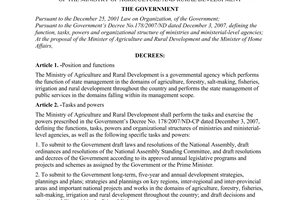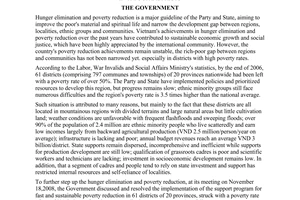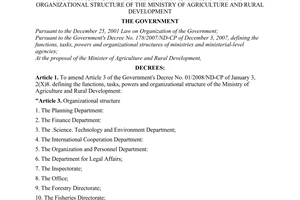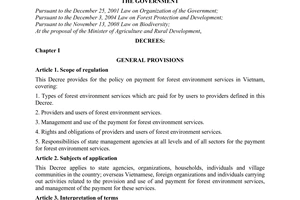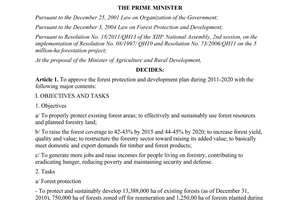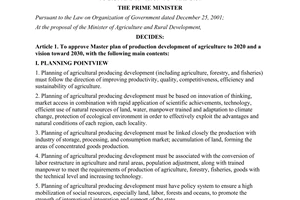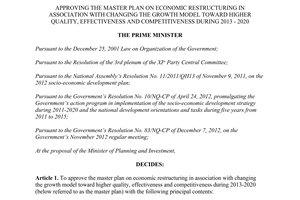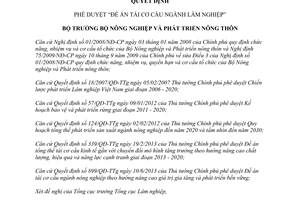Nội dung toàn văn Decision No. 1565/QD-BNN-TCLN approving the forestry sector reform proposal
|
MINISTRY OF
AGRICULTURE |
SOCIALIST
REPUBLIC OF VIETNAM |
|
No: 1565/QD-BNN-TCLN |
Hanoi, 08th July 2013 |
DECISION
ON APPROVING THE "FORESTRY SECTOR REFORM PROPOSAL"
MINISTER OF AGRICULTURE AND RURAL DEVELOPMENT
Pursuant to the Government’s Decree No.01/2008/ND-CP dated 03 January 2008 on regulating the functions, responsibilities and organizational structure of Ministry of Agriculture and Rural development and the Government’s Decree 75/2009/ND-CP dated 10th September 2009 for amending the Article 3 of the Decree No. 01/2008/ND-CP regulating the functions, responsibilities, mandates and organizational structure of Ministry of Agriculture and Rural development;
Pursuant to the Decision No. 18/2007/QD-TTg dated 05/02/2007 of the Prime Minister on approving the Viet Nam Forestry Development Strategy for the period 2006-2020;
Pursuant to the Decision No. 57/QD-TTg dated 09/01/2012 of the Prime Minister on approving the Forest Protection and Development Plan for the period 2011 - 2020;
Pursuant to the Decision No. 124/QD-TTg dated 02/02/2012 of the Prime Minister on approving the Overall Master Plan on Agricultural production Development until 2020 with visions towards 2030;
Pursuant to the Decision No. 339/QD-TTg dated 19/2/2013 of the Prime Minister on approving the Overall Economic Structure Reform Proposal in combination with shifting the growth model towards improving quality, efficiency and competitiveness capacity for the period 2013 - 2020;
Pursuant to the Decision No. 899/QD-TTg dated 10/6/2013 of the Prime Minister on approving the Agricultural Sector Reform Proposal towards value addition and sustainable development;
In view of the proposal of Director General of Administration of Forestry,
DECIDES:
Article 1. Approve the Forestry Sector Reform Proposal with the following elements:
I. OBJECTIVES
1. Overall objectives
To develop a forestry sector that is sustainable in aspect of economy, society and environment; gradually shift the growth modality towards an improved quality, efficiency and competitiveness capacity.
2. Specific objectives
- To improve the added values of forest environmental products and services; increase the annual average production values by 4 – 4.5%;
- To gradually meet with demand of timber and timber products for domestic markets and export;
- To contribute for job creation, hunger elimination, poverty reduction, livelihood improvement, ecologically environmental protection to aim for a sustainable development.
II. ORIENTATIONS
1. Forest structure
- The forestry land area by 2020 is estimated to be around 16.2 - 16.5 million ha, of which production forests account for 8.132 million ha meanwhile protection forests and special use forests account for 5.842 million ha and 2.271 million ha respectively.
- Protection forests: 5.842 million ha, mainly in very critical areas, including 5.6 million ha of watershed protection forests, 0.18 million ha of wave-break and sea encroachment protection forests, 0.15 million ha of wind-and-sand-shielding protection forests, 70 thousand ha of environmental protection forests for big cities, industrial zones and national border and island protection forests.
- Special use forests: strengthen the current forest area of 2.14 million ha with aiming to improve forest quality and biodiversity values, ensuring that forest quality-based criteria are met. For the ecosystems not yet, or poorly represented in the special use forest systems, it is possible to invest in developing some new areas in Northern mountainous region, North Central region, Central Highlands, and wetland in Northern and Southern delta regions with the area of around 60 thousand ha.
- Production forests: 8.132 million ha, of which 3.84 million ha is plantation production forest (including current 2.4 million ha of plantation forests, 1.0 million ha of new plantation forests and 0.35 million ha restored from restoring critically poor natural forests and 1.2 million ha shall be arranged for planning and constructing concentrated areas planting forest of big timber type to supply materials for the processing industry.
2. Increasing the added values of the sector
a) Change the synthetic approach under the chain from the step of creating materials to harvesting, processing and consumption where timber product markets (domestic and export) and policy mechanism play critical roles in orientating the structure of key trees for plantation to serve for timber product production.
b) Develop, increase forest quality
- Natural forests:
+ Increase the timber reserve of natural production forests by 25% of the current volume, achieving the average growth of 4-5 m 3/ha; improve the quality of natural forests to ensure commercial timber proportion is of 75% of total standing trees. Take care 0.7 million ha of rehabilitated forest; regenerate 0.75 million ha; enrich 1.1 million ha of forests; restore 0.35 million ha of critically poor forests.
+ The forest area that is eligible for selective harvesting should have been around 50 thousand ha in 2015, around 117 thousand ha in 2020 and around 215 thousand ha in 2030 with the average harvesting volume is 30 m3 /ha.
- Plantation forests:
+ Increase the forest productivity to reach an average of 15 m3 /ha/year. By 2020, production plantation forests shall account for about 3.84 million ha. An area of 0.25 million ha shall be harvested and re-planted every year with the average volume of around 150 m3/ha for big timber forests following a growth cycle of 12 years; 70 m3/ha for small timber forests following a growth cycle of 7 years.
+ Improve forest quality to make sure 80% of forest reserve is commercial timber, of which 40% is big timber and 60% is small timber.
+ Increase the application of newly recognized forestry tree seedlings into production to 60-70% in 2020, ensuring sufficient supply of qualified seeds, contributing to increase plantation forest productivity by 10% in 2015 and by 20% in 2020 compared with that in 2011.
c) Develop timber processing industry
- Timber processing and trade industry have always been considered a driver to develop forestry-based economics in Viet Nam and to shift it into an advanced, modern and synchronous production industry (from material production, supply to processing and consumption) that has high competitive ability, increase export turnover and meet with domestic demand for consumption and engage all economic sectors.
- Reform the structure of timber products and NTFP-based products, especially the products for export by increasing the values of timber products made from domestic materials, promoting both outdoor and indoor furniture in a harmonized manner, minimizing the export of raw products (including wood-chips).
- Make region and sub-region-based product master plan in conjunction with material timber forest plantation to ensure general investment efficiency.
- Timber product structure in the domestic market: furniture: 45%, artificial board: 55% (MDF: 26%, finger joint board: 26%).
- Production of artificial board: 2.3 million m3 of products in 2015, 3.0 million m3 of products in 2020 and 3.9 million m3 of products in 2030.
- Production of furniture: domestic furniture: 2.8 million m3 of products in 2020 and 4.0 million m3 of products per year in 2030; furniture for exports: 5.0 million m3 of products in 2020 and 7.0 million m3 of products in 2030.
- Increasing the utility of domestic material timber to reduce imported material timber for the timber processing industry. By 2015, domestic material timber available to supply to the processing industry shall reach 10.5 million m3, meeting around 50% of demand; by 2020, the productivity shall be 14.5 million m3, satisfying with 62% of demand; by 2030, the productivity shall be 24.5 million m3, satisfying with 75% of demand.
- Scope of timber processing enterprises:
+ Review, foster and upgrade the small and medium-sized timber processing facilities together with scaling up big timber processing facilities.
+ Make plans, arrange factories in a region-appropriate manner, with priorities are given to construct factories in mountainous regions where materials for processing are sufficient in order to create jobs and income for people, contributing to promote industrialization, modernization of rural and mountainous areas; such processing factories can bear a capacity of 60,000 - 100,000 m3 of MDF/year, 20,000 m3 particle board/year and 10,000 m3 furniture/year.
- Develop wooden art handicraft villages: upgrade some home furniture processing villages, streets in North-East Region and Central Region to be enterprises, cooperatives; develop industrial cluster in rural areas, mainly for processing home-use furniture to serve for domestic markets; linking with large-scale timber enterprises in the region.
- Provide assistance to develop non-timber forest product processing enterprises that extract natural substances from herbal plants; timber and bamboo handicraft enterprises and facilities.
3. Economic sectors in the forestry
a) Forest management organizations
- Reform the structure of forest management entities following the direction that state-owned organizations directly manage around 50% of total natural forest areas, including the entire area of special use forests, 65% of protection forests and 30% of production forests.
- Review, re-arrange the current forest management boards and establish new ones following the forest re-planning.
- Strengthen forest protection and management organizations in a sustainable manner and in line with international integration, ensuring the consistency between relations of production and forces of production in the forestry.
b) State forestry companies transformed from state-owned forestry farms
Based on the review of forest planning, forestry companies shall be transformed into:
- Joint-stock companies where the State holds a dominant proportion of shares
- Forest management boards.
- Dissolved or transformed into other forms.
c) Develop private and collective economics
- Develop forestry-based collaboration modalities; increase the number of forestry-based cooperatives to at least 200% in 2020 compared with 2011.
- Promote, create favorable conditions in terms of institutions and provide diversified, flexible collaboration modalities so that farmers and households can contribute their land use right together with enterprises to accumulate land for large-scale forestry production.
- Promote the roles of farms and household farms; exploit and take advantages of positive strengths of a tropical forestry, construct and development large-scale specialized production zone in the forms of farms and households; develop criteria for household farms, increase by 150% number of forestry households in 2015 and 200% in 2020 compared with that in 2011.
4. In terms of mobilization and utility of financial resources
a) State budget investment
In the period 2011 - 2020, the capital allocated from state budget shall still increase thanks to the implementation of new policies and mechanism over Special use forests.
In the period 2013 - 2020, ODA for forestry sector is forecasted to account for from 18% to 20% of the total capital demand with an annual average of around 700 - 800 billion dong (direct investment into forest protection and development ranges from 250 billion to 400 billion). This is the investment capital was used to be the foundation to allocate budget over forest protection and development in localities, regions involving forest protection and development projects.
b) Non-State budget investment
Non-State budget investment is the key financial source mobilized and used for developing the forestry sector in the next period. To plant nearly 3 million ha of forest, it is required to have around 40 trillion dong or 71% of total capital demand. Capital generated from forest environmental service payment shall increase sharply in the next time, expected to be over 1,000 billion dong/year. In addition, it is necessary to mobilize potential income from other financial assistance sources.
5. Development of forestry ecological economic regions
a) North-West Region: develop and foster the system of watershed protection forests, special use forests and natural production forests in the basin of terrace hydropower plants to maximize the protective efficiency and facilitate for localities to get more benefits from the forest environmental service payment.
b) The North-East: construct the biggest national timber material area to supply small timber material for paper industry and artificial board in the areas adjacent to processing factories; construct big timer material areas in farther locations; develop and foster the watershed protection forests, riverside protection forests.
c) Red River Delta Region: promote plantation of dispersed trees, create timber supply sources for home use for lowland provinces.
d) Central Northern Region: construct the second national largest big timber material area to supply timber material for paper industry and artificial board in the areas adjacent to processing factories, construct big timber supply area in farther locations to supply for furniture processing factories inside and outside the region; establish and forester the system of watershed protection forests in Annamite range, sand-and wave-shielding riverside protection forests, wave-breaking and sea-slide preventing protection forests.
dd) The Southern Coastline Region: construct the national third largest timber material area to supply big timber material for the timber processing industry in the region and the South-East Region; develop and foster the system of watershed protection forests, sand-and wave-shielding riverside protection forests, wave-breaking and sea-slide preventing protection forests.
e) Highland Region: foster, protect natural watershed protection forest to maintain the natural forest coverage via co-management and community-based forestry modalities.
g) South-East Region: foster and protect watershed protection forests for keeping hydropower, hydraulic plants safe and protecting environment for industrial zones in the region.
h) Mekong Delta River: develop and foster riverside wave-breaking protection forests; restore and develop mangrove and Malaleuca ecosystems to serve for environmental protection and economic development; promote the combination of agro-forestry-fishery production to ensure the sustainable development.
III. SOLUTIONS
1. Reviewing, planning of forest protection and development
- Improve quality of planning; link strategies with master plans, plans, improve efficiency of state administration over forest protection and development planning.
- By 2015, complete the review of forest planning, identify the appropriate area of watershed forests, special use forests to maintain (national stable forest stand), transform the remaining forest areas to be centralized material areas.
- Implement Forest Protection and Development Planning at Central level, sub-national level and in each locality following the reformed structure via the implementation of Forestry Planning Projects.
- Implement material area development master plan for timber processing industry until 2020 and orientations towards 2030 at national level and by each forestry economic-ecological region.
- Review, identify the current status of using forest and forestry land by management entities, adjust and reclaim land allocated to organizations, households which have been assigned to organizations and individuals but not effectively used or misused.
- Makes plans over and manage field cultivation area, ensure to maintain a stable cultivation area for people.
2. Increase the added values of the sector
- Develop, improve forest quality: organize to implement the following Proposals:
+ Forestry Seed Quality Improving Proposal for the period 2011-2020. At least 10-15 new seeds (acacia, eucalyptus and some other key seeds) shall be selected and developed.
+ Proposal on improving productivity and quality of Viet Nam's forests: develop high-yield production plantation forest, increase the proportion of material timber supplied to processing and furniture industry (big timber); identify suitable seedlings for planting production forests and plant dispersed trees to meet with demand for timber processing of 6-8 ecological regions; develop sustainable forest intensive-cultivation technical standards.
- Fully implement forest environmental services-related activities, including carbon markets; researching to provide technology solutions for monitoring and supervising forest, potential forest environmental services.
- Focus on highly competitive products.
- Emphasize to scale up artificial board processing, gradually reduce the processing of paper wood chips for export; promote the utility of products made from artificial board and plantation timber.
- Diversify and improve quality and appearance of timber products to meet with consumer tastes. Promote the development of trademarks and issuance of certificates to export products together with establishing an effective distribution system.
- Establish material areas adjacent to timber processing and furniture facilities.
- Make investment in forestry infrastructure (roads, fire-resistant barriers, etc, forest fire suppression equipment) by state budget and contribution of enterprises to reduce production costs (transporting seedlings, fertilizer, travelling, moving harvested timber, forest fire fighting).
3. Forest management and production organizations
a) Review, re-arrange forest management organizations based on the findings of forest re-planning, and delineate national stable forest stand and areas for developing material.
b) Reform forest management mechanism and organization towards enhancing autonomy for households, forest management boards and enterprises via the Forest Management Organization Reform Proposal.
c) State forestry companies
- In terms of land:
+ Review land availability, demarcate and issue land use right certificate that shall be completed in 2015. Budget shall be allocated by the State.
+ Review, transfer land to localities, complete in 2014.
+ Continue implementing forest contractual allocation policies, piloting forest co-management mechanism.
+ Scale up joint ventures, partnership and collaboration between forestry companies and other economic sectors, with domestic and foreign organizations, individuals in terms of production, processing and consumption; create stable and close linkage between material areas, material suppliers with agro-forestry processing facilities.
+ Address the land-related shortcomings and obstacles.
- In terms of finance, investment, credit: focusing on handling public debt, assets attached to land, developing typical financial mechanism.
- Re-arrange labor force.
d) Private economics, collective economics
- Private economics:
+ Review, issue land use right certificates to households, individuals.
+ Review the planning of agro-forestry production development, determine areas for developing forestry farms, household farms, create favorable conditions for accumulation of production forest land to scale up household forestry farms and private enterprises, publicize land availability that can be allocated or leased to develop forestry farms.
+ Encourage households to scale up their production, doing business and services, trade promotion.
+ State supports households, individuals, farms to establish forest owner associations.
- Collective economics:
+ Establish joint venture, partnership among economic sectors, and within an economic sector, especially the joint venture, partnership between forestry companies and households to plant material forests, process and sell products.
+ Encourage the collaboration between enterprises and actors in forest plantation, harvesting, processing, servicing, etc to establish value chain of forestry products, increase competitiveness in domestic and international markets.
+ Enable farmer households to cooperate with collectives to plant forests in compliance with the common forest management plans of cooperatives, cooperation groups and in harmonization with production plans of households and such common plans to ensure a large and stable enough area to ensure sufficient supply of annual timber volume to the market.
4. Development of human resources
- Develop incentive policies to attract forestry-based labor to work for forestry companies, state forest management boards.
- Encourage, create favorable conditions for enterprises and training organizations to cooperate and support each other in training and improving working skills for laborers of enterprises.
- Organize occupational training for laborers: scale up the forms of occupational training in combination with transfer of new technology and techniques and new production procedures for farmer households; train handicraft villages, specialized production areas.
- Strengthen domestic and overseas training forms for managers, researchers and marketing officials to improve capacity and widen the force of outstanding timber traders in international markets.
5. Promotion of production in the form of collaboration, centralization and generalization in timber processing industry
- Re-arrange production following chain of products (vertical chain) from forest planting, material collecting to processing and consumption.
- Establish large and medium-scale enterprises in each economic region. Strong and locomotive enterprises shall take lead in linking with production chains of each key product, especially products for export.
6. Extension of markets
a) International markets
- Projections, negotiation, signing of bilateral, multi-lateral international agreements (Voluntary Partnership Agreement between European Union and timber exporting countries, etc) in line with the integration roadmap to International Trade Organization and minimize risks from involvement in international trade for enterprises.
- Trade promotion: develop professional exhibit centers for furniture in 3 regions, develop information center for timber processing and trade to understand market demand and changes, provide incentives to support Viet Nam's timber enterprises to take part in overseas furniture trade fairs.
- Commercial counsellors in foreign countries: support and provide information on furniture market and legislation of those residential countries to Timber Processing Associations in Viet Nam; organize trade promotion and marketing events (especially in new markets such as Russia, Eastern European, Latin-America, etc).
b) Domestic markets
- Foster distribution and consumption channels for timber products, organize system of timber product wholesale in localities with big demand such as Hanoi, Ho Chi Minh cities, etc in a civilized and modern manner.
- Promote private trade mark for timber products.
- Conduct market supervision and monitoring for timber products that have been registered quality and labeled.
7. Sources and utilization of investment
Mobilize and integrate sources, plans, programs, projects; manage and operate a new financing mechanism. Integrate forest protection and development plans with socio-economic development plans and other programs, projects in the same locality to improve the overall efficiency of socio-economic development, environmental protection, national security and defense.
Capital for investment and development from State budget is focused for large-scale protective afforestation projects, national parks, projects in the districts subject to the Resolution 30a/2008/NQ-CP of Government on the rapid and sustainable poverty alleviation program to 62 poor districts, North-West and Central Highland Region; supporting for promoting production forests; supporting for constructing forestry roads in centralized materials areas where transportation is still a barrier; researching and experimenting projects; projects on investment in advanced technology equipment and information technology application into forest planning, management and protection; investment in research, application of advanced technology in seed selection, production and intensive afforestation. Local state budget is allocated to remaining projects in line with the standard policies.
- State budget for economic development is allocated to contract forest protection for special use forests, critical protection forests that are highly risky to be encroached, regeneration, forest and forestry land status monitoring and other non-business expenditures.
- Implement "Orientations for mobilization, management and utilization of ODA, preferential loan and international assistance for forestry sector in the period 2013-2020" in line with making priorities for implement the objectives specified in the Forestry Development Strategy and Forest Protection and Development Plan for the period 2011-2020.
- Scientific research budget is allocated for researching the application of tested seeds, conduct inventory for field delineation to determine appropriate forest plantation area with such tree seeds and transfer technology on intensive plantation of big timber and small timber for different ecological regions;
- Transfer technology of planting big timber and high yield seeds from other countries with similar conditions with Viet Nam by using state budget, ODA, FDI and contribution of large-scale enterprises;
- Capital from non-state budget is focused for making investment to develop production forests, non-timber forest products, timber product processing and consumption, making use of forest-based benefits and services; trade promotion and market development; investment in the areas that are used to be allocated with state budget such as developing forestry seeds, vocational training on forestry, providing forestry technical and extension services, etc.
- Other legitimate financial sources such as forest environmental payment services according to the Decree 99/2010/ND-CP carbon credit, etc are balanced with state budget, ODA, non-state budget to maximize their effectives to well implement the tasks on forest protection and development assigned by the Government.
- Review, supplement and develop new investment plan, financial plan for forestry sector for the period 2012-2020 to integrate all appropriate financial resources in the new structure.
8. Policies, mechanisms
- Review, supplement, amend, develop new mechanism, policies; establish new financial institutions (Resolutions of the Party, Laws, Ordinances, Decrees, Decisions, Regulations on management, utilization of budget, investment, credit, mobilization and utilization of resources, etc), execute such legislations in a coherent and effective manner to mobilize, coordinate, socialize and use effectively such financial resources for developing the forestry sector.
- Implement the "Orientations for mobilization, management and utility of ODA, Referential Loan and other international assistance for forestry sector for period 2013-2020".
- Develop policies on supporting initial investment, credit loan to plant forests in line with each type of forest trees that shall be returned when such trees are eligible for main harvesting.
- Research to propose mechanisms, policies for sustainable management of natural forests in according to forests' functions (protection, special use and production), and policies for sustainable development of non-timber forest products.
- Research to propose incentive policies for mobilizing and using non-state budget for forest protection and development until 2020.
- Revise forest-based benefit policies.
- Pilot the forest co-management modality between forest management entities with local people and communities for replication.
- Pilot the public-private partnership modality in forest protection and development.
- Encourage, support collective economics via incentive policies, mechanism to organizations in partnership such as providing initial investment capital, application of advanced techniques, market access, etc.
- Develop policies, mechanism on linking timber producers, forestry companies with timber processing facilities, companies; encourage enterprises to make investment into forestry following closed modality that includes production, processing and consumption. Farmers who contribute capital to enterprises in the form of land use rights shall be considered share-holders of enterprises and shall be shared with benefits.
- Policy on encourage investment in constructing centralized material area to serve for timber processing industry.
- Having transparent policies for attracting FDI.
- Develop incentive policies in terms investment (credit, tax, rental fee, etc) related to land for enterprises processing MDF, finger joint boards.
- Develop credit incentive policies for handicraft villages and small processing facilities in rural areas to primarily process products to supply for secondary processing facilities to make finished products; long-term incentive credit for large timber plantation forest owners; enable farms, household farms to access to loan from the state development investment fund.
- Promotion policies for non-state economic actors to take part in developing plantation forests; encouraging issuance of certificates for plantation forests.
Article 2. Implementation organization
1. Viet Nam Administration of Forestry
a) Develop an Action Plan to implement the solutions for the Proposal in the period until 2015 and from 2016 to 2020, make periodical reports on progress and implementation result to Ministry.
b) Take lead and cooperates with relevant Departments to develop and organize the implementation of the following programs, proposals and tasks:
- Proposal on Management of Improving Quality of Forestry Seeds for the period 2012-2020;
- Proposal on Improving Management of timber Harvesting from natural Forests for the period 2013-2020;
- Proposal on Improving Quality of Production Forests for the period 2012-2020;
- Proposal on Reforming the Mechanism and Organization of Forest Management for the period 2013-2020;
- Proposal on Organizing Forest Management and Protection in the Highland Region;
- Orientations for attracting, managing and using Official Development Assistance, preferential loan and other international assistance for the forestry sector in the period 2013-2020;
- Improving capacity for Viet Nam Forest Protection and Development Fund;
- Other relevant programs, proposals.
2. Agencies under Ministry of Agriculture and Rural development
Pursuant to the functions, responsibilities, organize the implementation of the following proposals:
a) Agro-Forestry-Fishery Processing, Trade and Salt Production Department: implement the Viet Nam Timber Processing Industry Master Plan until 2020 and orientations towards 2030.
b) Department of Science, Technology and Environment: take lead, cooperate with other agencies to review, amend, supplement, develop new criteria, national standards in the forestry sector in line with international and regional standards; research and transfer new technology into production in order to improve productivity, quality of forest and timber products.
3. Localities
Provincial Departments of Agriculture and Rural Development advise People's Committees of provinces, cities managed by the Central level:
a) Implement in a coherent manner the solutions on land planning, forest protection and development planning, production structure, market, capital, human resources by maximizing strengths of each locality and competitiveness of products; complete the approval of measures on re-arrangement, reform, equitization of state forestry enterprises under the mandate of each locality.
b) Direct, organize the implementation of Viet Nam Timber Processing Industry Master Plan until 2020 and orientations towards 2030 in line with specific local context.
Article 3. The Decision comes into effect since the signing date.
Article 4. Head of Ministry's Office, Director General of Forestry Administration, Heads of relevant agencies under Ministry, Provincial Departments of Agriculture and Rural development of provinces, cities managed by the Central level are responsible for executing the Decision./.
|
To: |
MINISTER |
------------------------------------------------------------------------------------------------------
This translation is made by LawSoft and
for reference purposes only. Its copyright is owned by LawSoft
and protected under Clause 2, Article 14 of the Law on Intellectual Property.Your comments are always welcomed

